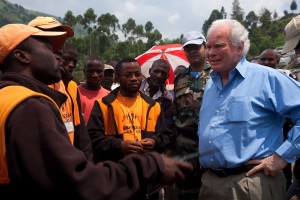December 13, 2010

Ross Mountain, DARA Director General, previously UN Humanitarian Coordinator in the DRC receives briefing from representative of local NGO during a visit to IDP camp in Masisi, North Kivu.
We need to provide more effective and targeted assistance to victims and stronger donor leadership
By Ross Mountain
The importance and significance of donor governments is indispensable for ensuring both that affected populations receive the best assistance possible but also that the now considerable resources allocated to humanitarian aid are most effectively utilised.
In 2003, a group of the world’s major traditional donors agreed a set of 23 principles that constitute the Good Humanitarian Donorship (GHD) Initiative. Ready to be launched next month for the fourth consecutive year, the goal of the Humanitarian Response Index (HRI) is to assist donor governments in meeting the objectives to which they themselves signed up to as part of their GHD commitment.
The objective of the HRI is not the donor ranking but to provide feedback to those responsible for humanitarian policymaking on how their efforts are seen from the ground with the view of helping to improve aid efficiency for the benefit of those who need to receive it.
My first awareness of and interaction with the HRI and DARA colleagues was in the Democratic Republic of the Congo (DRC), where I served, among other roles, as the UN Humanitarian Coordinator. During the inevitable series of evaluations of the programmes for which I was responsible, I was struck by the novelty of an approach that looked not only at the amount of money made available by donors but also at the way in which these funds were allocated and how other support was provided. This highlighted in my mind the important role that can be played by donors in meeting urgent humanitarian needs beyond the cash component – vitally important though it is and will remain.
In the DRC, the humanitarian operation came to serve as something of a guinea pig for the UN humanitarian reform process launched in 2005. This involved implementation of the cluster system (both in the capital and at regional level), establishing a pooled fund to encourage more pragmatic and prompt response to needs, working with UN military forces to protect civilians and designing comprehensive and transitional strategies that addressed the population’s need for security as well as social services and governance.
While for many these new mechanisms were objectives in themselves, we sought to apply these approaches in a way that put the beneficiary in the centre. Thus, the objective was to find the speediest targeted delivery approaches that could maximise the use of the resources that were always limited in relation to the challenges, notwithstanding the generosity of donors.
In its systematic sounding of key partners in crises countries, the HRI is unique. Some will find the rankings resulting from this independent analysis surprising or even unfair. Yet they should be viewed as a reflection from the field of how governments in their roles as humanitarian donors are regarded by their partners.
I hope that the HRI 2010 will lead those in the headquarters of donors, NGOs and UN agencies – and governments in crisis-affected states – to reflect on the measures they may have put in place. I urge them to particularly study our findings on the risks that political instrumentalisation can have by inhibiting the most effective delivery of humanitarian assistance to those in need. The importance of humanitarian assistance being available to victims irrespective of the leadership or political regime that governs them is a cardinal principle.
In a year that has seen two huge natural disasters – in Haiti and in Pakistan –we need to find ways to provide more effective, targeted and quicker assistance to victims of crises, primarily for their sake but also to be able to assure those contributing funds through government and non-government programmes that we are doing the best we can.
Share this